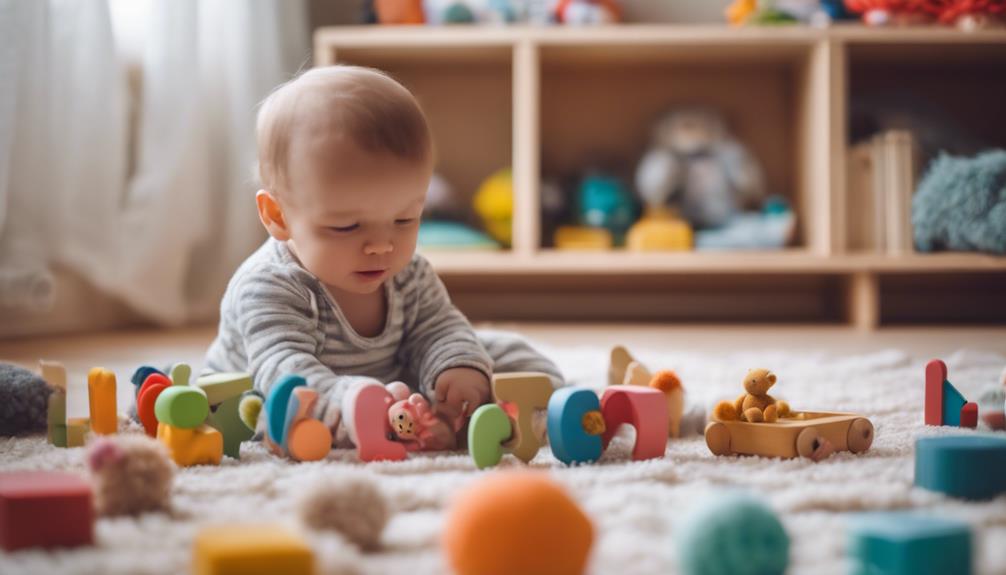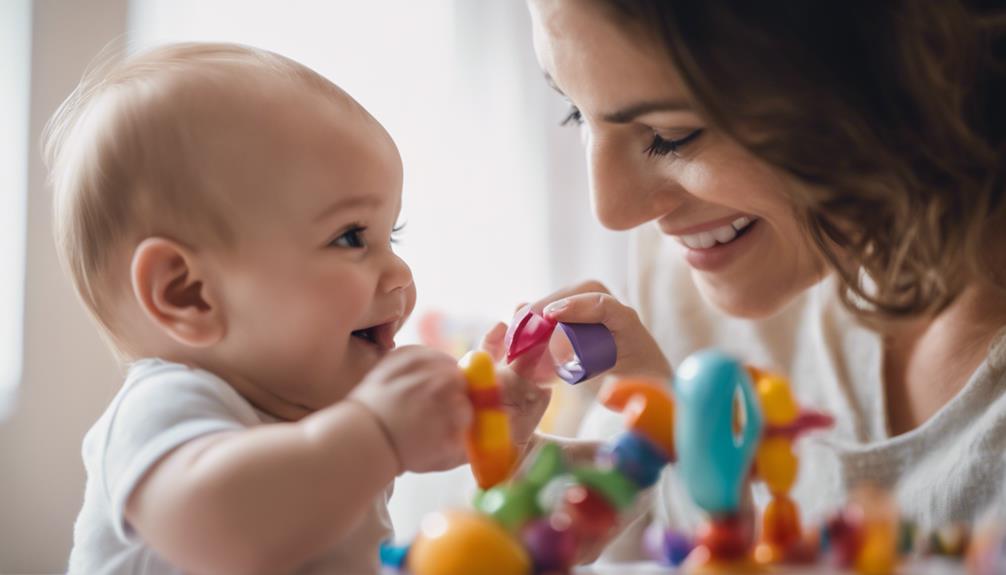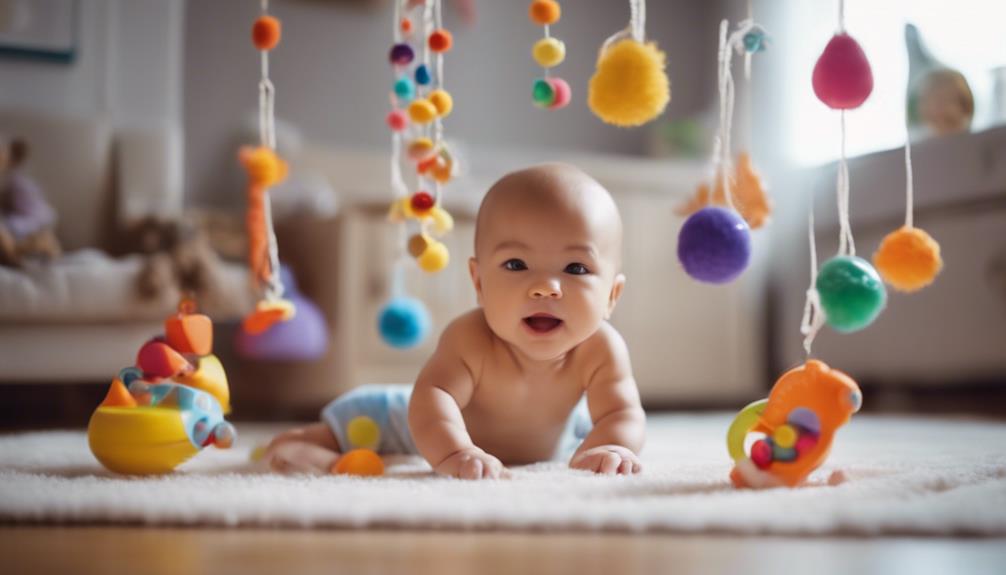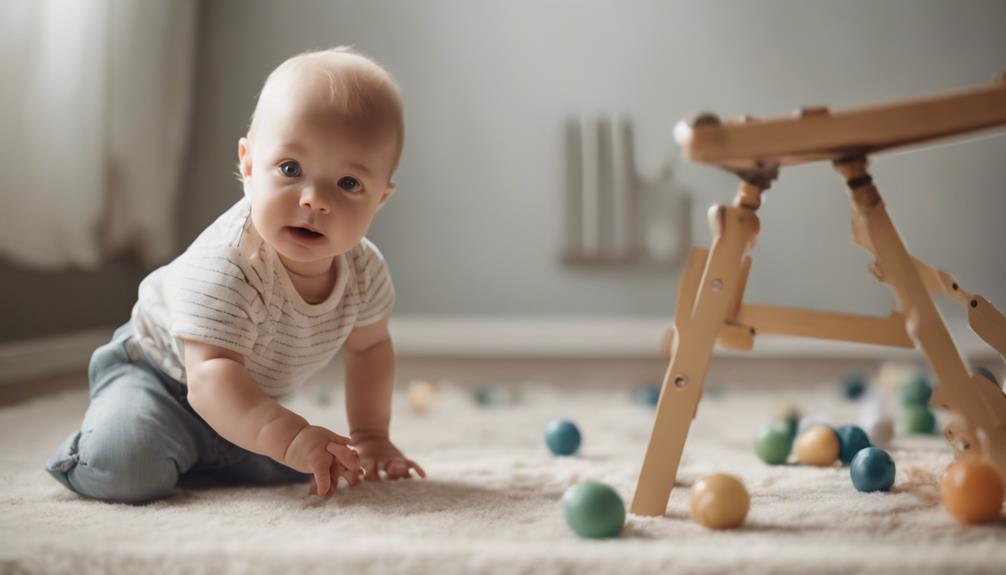To enhance your baby’s brain development, make early interactions such as serve-and-return play a priority. These interactive exchanges help create vital neural connections, laying the foundation for healthy cognitive progress. Establish a stimulating environment with colorful, textured toys to engage their interest and promote cognitive advancement. Limit screen time and offer alternatives like reading and playing with toys. Ensure proper nutrition, adequate sleep, and participate in meaningful conversations to support language development. Encourage imaginative play to enhance cognitive and social skills. Attentive caregivers play a crucial role in shaping neural connections and social-emotional development. Embrace these strategies to maximize your baby’s brain development even further.
Key Takeaways
- Engage in interactive play and conversation for brain stimulation.
- Provide a variety of sensory experiences with colorful toys.
- Limit screen time to support healthy cognitive growth.
- Ensure proper nutrition and consistent sleep routines.
- Foster secure attachments through responsive caregiving.
Importance of Early Interactions
Early interactions with caregivers play a pivotal role in shaping a baby's brain development. These initial exchanges form the foundation for your cognitive and emotional growth.
When caregivers engage in serve-and-return interactions with you, where they respond to your cues and actions with warmth and attentiveness, they're actually stimulating neural connections in your brain. This back-and-forth interaction is like a tennis match, with each 'serve' and 'return' strengthening your brain's architecture.
By actively participating in these interactions, you're laying down the groundwork for healthy brain development.
Positive interactions with caregivers not only contribute to your cognitive abilities but also promote emotional well-being. The quality of these early interactions and relationships with your caregivers can have a profound impact on your brain development in the critical early years of your life.
Creating a Stimulating Environment

To create a stimulating environment for your baby's brain development, provide a range of colorful and textured toys that engage their senses and encourage exploration.
Visual stimulation through vibrant colors can captivate their attention and promote cognitive growth.
Engaging Sensory Play
Create a stimulating environment for your baby by engaging in sensory play with a variety of textures, sounds, and colors. Sensory play is an important tool to stimulate brain development and cognitive growth in infants.
By providing toys with different textures, such as soft blankets or rattles that produce different sounds, you can help your baby explore their senses and make valuable connections in their brain. Incorporating sensory activities like gentle massages and introducing colorful objects like mobiles and mirrors can enhance your baby's sensory experiences, encouraging curiosity and exploration.
Through sensory play, your baby can develop essential cognitive skills as they learn to process and respond to various stimuli. This type of play not only aids in brain development but also fosters a sense of wonder and discovery in your little one.
Colorful Visual Stimulation
How can you maximize your baby's visual development through colorful visual stimulation in their environment?
Colorful visual stimulation plays an essential role in enhancing your baby's brain development and cognitive skills. Babies are naturally drawn to high-contrast colors like black and white during their early months, making them ideal for visual stimulation. Hanging colorful mobiles above the crib can captivate your baby's attention and promote visual tracking abilities.
Introducing a variety of colorful toys, books, and artwork into your baby's surroundings can further enrich their visual development. By providing a diverse range of colors and patterns in your baby's environment, you stimulate their brain activity and support cognitive growth.
Creating a visually stimulating environment not only engages your baby's senses but also contributes significantly to their overall cognitive and perceptual development. So, surround your little one with a vibrant array of colors to enrich their visual experiences and foster healthy brain development.
Limiting Screen Time

Limiting screen time for babies under 18 months is essential to support healthy brain development.
Excessive exposure to screens can impede cognitive growth, affecting language skills and attention span negatively.
Setting boundaries and offering alternatives, such as interactive play and exploration, foster a more stimulating environment for your baby's brain development.
Screen Time Impact
To support healthy brain development in babies, it's essential to adhere to recommended guidelines on screen time limits set by experts.
Screen time can have a significant impact on the brain development of infants and toddlers. The American Academy of Pediatrics suggests no screen time for children under 18 months and limited high-quality programming for those aged 18-24 months.
Excessive screen time has been linked to delayed language development, poor sleep quality, and decreased cognitive skills in babies. Research indicates that screen time before bedtime can disrupt sleep patterns, affecting brain development in young children.
By limiting screen time, parents enable their babies to engage in more interactive activities that promote social, emotional, and cognitive development. Monitoring and restricting screen time play an important role in supporting healthy brain development in infants and toddlers.
Alternatives to Screens
To promote healthy brain development in babies, exploring engaging alternatives to screens provides valuable opportunities for cognitive growth and stimulation. Limiting screen time and incorporating real-world interactions are key in enhancing baby brain development.
Here are some effective alternatives to screens:
- Reading Books: Reading to your baby not only helps with language development but also fosters a love for learning and exploration.
- Singing Songs: Music is a powerful tool for brain stimulation. Singing songs to your baby can improve their auditory processing skills and emotional development.
- Playing with Toys: Hands-on play with toys encourages sensory exploration, fine motor skill development, and creativity in babies.
Setting Boundaries At-Home
Establish clear boundaries at home to regulate screen time for your baby, ensuring healthy brain development and overall well-being. Limiting screen time for children under 18 months is vital as it can prevent negative effects on their brain development. The American Academy of Pediatrics advises no screen time for this age group and limited exposure to high-quality programming for older children. Excessive screen time can impede language development, cognitive skills, and social interactions in babies, highlighting the importance of setting boundaries.
By controlling screen time, you promote healthier sleep patterns and physical activity, both essential for your child's brain development.
Instead of screen time, prioritize face-to-face communication and interactive play with your baby. These activities stimulate their brain in ways that screens can't replicate, fostering language skills, emotional connections, and cognitive abilities. Investing time in direct interaction with your child not only benefits their brain development but also strengthens your bond and communication skills.
Nurturing Nutrition and Sleep

Proper nutrition and sufficient sleep are essential for nurturing your baby's brain development. Ensuring your baby receives the right nutrients and ample rest is fundamental for ideal brain function and growth.
To support your baby's brain development, consider the following:
- Breast milk or formula: Providing the right nutrition, such as breast milk or formula, is essential for supporting brain growth and development in babies.
- Omega-3 fatty acids: Including omega-3 fatty acids in your baby's diet is necessary as they play a key role in brain health and development.
- Consistent sleep routine: Establishing a consistent sleep routine helps optimize brain development in babies, as adequate sleep is critical for memory consolidation and cognitive function.
Engaging in Meaningful Conversations

Engage your baby in meaningful conversations to promote language development and cognitive skills effectively. Talking to your baby not only helps in building a strong bond but also plays a significant role in stimulating your baby's brain.
When you engage in conversations with your little one, you're providing them with a rich vocabulary and encouraging back-and-forth dialogue, which are essential for language development. These interactions help babies learn about communication, emotions, and social interactions, laying a strong foundation for their cognitive skills.
Moreover, incorporating conversations into daily activities such as feeding or diaper changes can further enhance your baby's brain development. Encouraging your baby to respond with coos, babbling, or gestures also aids in building their communication skills.
Encouraging Pretend Play

Encouraging your baby to participate in pretend play can greatly enhance their cognitive development and creativity. Pretend play involves using imagination to create scenarios and roles, providing numerous benefits for your baby's overall growth and learning.
Here are three key advantages of encouraging pretend play:
- Development of Cognitive Skills: Pretend play helps babies enhance problem-solving abilities and fosters creativity by allowing them to think outside the box.
- Enhanced Social and Emotional Skills: Engaging in imaginative play enables babies to explore different social roles and emotions, promoting empathy and understanding of others.
- Stimulated Language Development: Role-playing activities during pretend play encourage babies to communicate, improving their language skills and vocabulary.
Role of Attuned Caregivers

Attuned caregivers play an essential role in shaping a baby's brain development through their responsive interactions and nurturing presence. By promptly responding to a baby's cues and needs, these caregivers help build strong neural connections in the infant's brain. This responsiveness leads to the development of secure attachments, which are fundamental for healthy brain growth. When babies feel safe and supported by their attuned caregivers, they're more likely to thrive emotionally and cognitively.
Research indicates that babies who've attuned caregivers exhibit better cognitive, social, and emotional development outcomes. This is because attuned caregivers provide a nurturing environment that fosters the best brain growth. Through their interactions, these caregivers lay the foundation for the baby's future well-being.
Promoting Social-Emotional Development

To foster healthy social-emotional development in babies, focus on building relationships, managing emotions, and developing empathy.
- Engage in positive interactions: Regularly interact with your baby in a loving and responsive manner to create a supportive environment for their emotional growth.
- Form secure attachments: Make time for play, reading, and cuddling to establish a strong bond with your baby, helping them feel safe and secure in their relationships.
- Cultivate emotional connections: Connect with your baby on an emotional level by understanding and responding to their feelings, laying the groundwork for them to learn how to express emotions effectively.
These practices contribute to your baby's overall social-emotional development, providing them with the necessary foundation to navigate relationships, regulate emotions, and empathize with others.
Frequently Asked Questions
How Can I Stimulate My Baby's Brain Development?
You can stimulate your baby's brain development by engaging in interactive activities like reading, talking, and singing. Provide age-appropriate toys for exploration, create a stress-free environment, and encourage sensory experiences. Monitor milestones and seek guidance from healthcare providers for the best stimulation.
What Are 3 Ways That You Can Increase the Development of an Infant's Brain?
To increase your infant's brain development, engage in responsive interactions like talking and singing, expose them to sensory experiences, and encourage play with toys. Overcome the challenge of feeling overwhelmed by taking small, consistent steps each day.
How Can I Stimulate My Baby's Cognitive Development?
To stimulate your baby's cognitive development, engage in interactive activities like reading and talking. Provide age-appropriate toys for exploration. Foster sensory experiences through touch, sound, and visuals. Encourage imaginative play and create a nurturing environment for the best brain growth.
How to Increase IQ Level of Baby?
To increase your baby's IQ level, engage in interactive activities like reading, talking, and singing. Provide a loving environment and encourage exploration with age-appropriate toys. Limit screen time and focus on hands-on interactions. Foster emotional connections for brain development.
Conclusion
Now that you have learned the expert tips on stimulating your baby's brain development, it's time to put them into action.
By engaging in meaningful interactions, creating a stimulating environment, and fostering social-emotional growth, you can help your little one reach their full potential.
So, get ready to see those neurons firing and watch your baby's brain thrive as you implement these strategies.
The future is bright for your baby's brain development!










